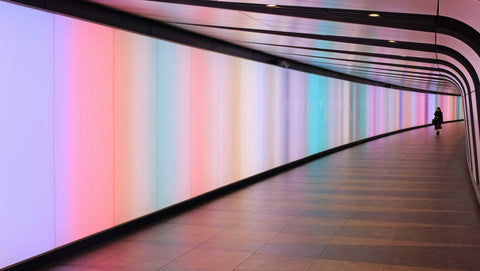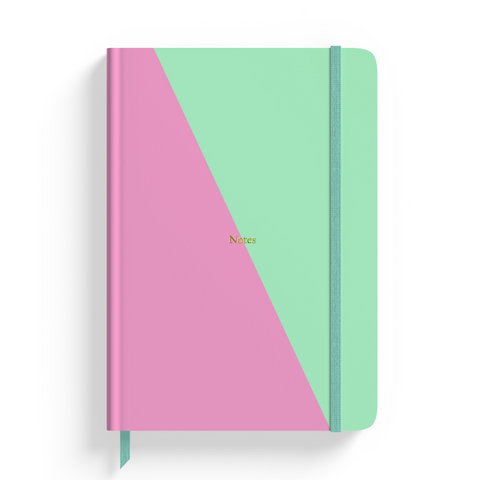Votre panier est vide
Menu

March 01, 2024
Colour Psychology: How Does The Colour of Your Stationery Make You Feel?
Yop & Tom
Have you noticed how your eyes naturally gravitate towards certain colours when you walk into a stationery store? How some colours feel more “you”, while others feel like an unnatural fit?
Some of that can be put down to personal preference. But a big part of it is to do with colour psychology.
Ever since Isaac Newton first refracted white light into each colour of the rainbow using the colour prism, humans have been fascinated by colours and the impact they can have on our wellbeing, mood and psychology.

What is colour psychology?
Colour psychology is the theory that different colours can have different impacts on our behaviour and emotions. Whilst one colour might bring calm and serenity, another might trigger angst and frustration.
Colour psychology is the study of why this happens. With colours being grouped together to correspond with different emotive states.
The branding and marketing industry uses colour psychology to transform how their consumers view different companies, even going so far as to change the colour of website buttons to encourage more people to make a purchase.
Why should you care about colour psychology when choosing your stationery?
We all know that great design can impact how we feel when using a product. If something works well for us, feels luxurious and perfectly serves our needs, we’re far more likely to use it on a regular basis. Meaning all those benefits from journaling, goal setting and organisation are far more likely to make their way into your life.
Colour psychology takes that one step further.
It allows you to dive a little deeper. How do you want to feel when you’re using your journal, notebook or planner?
Are you looking to feel calm? Energised? Inspired? Relaxed? Focused? Or something else entirely? Whatever it is, the colour of your stationery can help you achieve that.
But what about colour therapy?
Interior designers will often use colour therapy to bring different tones and emotions into our physical spaces.
You’ve probably noticed that most hospital rooms are blue. There’s a reason for this. Anecdotal evidence suggests that the colour blue can bring down your blood pressure and slow your heart rate.
So if hospitals are paying attention, we think we should be too.
You have your own colour psychology
We’re about to dive into the theory behind colour psychology. But before we do, remember this.
You have your own colour psychology.
You have your own past, your own history, your own life story. And all of these influence how you feel around certain colours. Some might trigger a sense of nostalgia whilst others will bring up old memories and emotions.
Whilst colour psychology can be used as a general guide, remember to bring your own history into play too. Only you can truly know how each colour makes you feel.
The basics of colour psychology

The colour psychology of red
Red is a bold colour, typically associated with feelings of passion and excitement. This translates through to its link with love.
It’s known to symbolise strength, confidence and power. Whilst, given its link with the colour of fire, it can also be used to represent heat and warmth.
If you’re looking for a bold confidence boost with your stationery, then red is the colour for you.
The colour psychology of pink
Pink can be linked with different emotions depending on the shade used. A paler pastel pink is considered soft, feminine and youthful. Whilst a vibrant bolder pink creates a sense of energy, fun and playfulness.
If you’re in need of an extra energy boost from your stationery, then pink is the colour for you.
The colour psychology of orange
Orange is a confident colour. It speaks of bravery and fresh activity.
It naturally creates a sense of warmth and optimism, hinting at a brighter future. Orange can also help with a feeling of possibility, freedom and positivity. There’s a reason why you’ll find orange used in so many charities’ branding.
If you’re craving more optimism from your stationery as you move towards your goals, then orange is the colour for you.
The colour psychology of blue
Blue is a very reliable colour. It’s been used by the military, big businesses and even royalty for centuries. Because of this, it creates a sense of strength, reliability and consistency.
At the same time, blue can also be used to build feelings of peace and calm.
If you need to remind yourself of how strong you are, whilst adding a sense of calm into your stationery, then blue is the colour for you.
The colour psychology of purple
Purple has long been the colour of royalty. But it also symbolises creativity, spirituality and escapism.
It’s a positive colour, that can feel a little whimsical at times, depending on the shade used. It’s link with the wealth can also help to create feelings of abundance.
If you need a little extra creativity from your stationery, then purple is the colour for you.
The colour psychology of green
You’ll likely already know that green is a very natural colour, given its association with nature and the environment.
Because of this, the colour green can indicate growth, renewal and depth. It helps to build a refreshing calming feeling.
If you’re looking for some gentle encouragement to grow from your stationery, then green is the colour for you.
Keen to take it up a notch? Dive ever further into colour psychology through the seasons
In the 1970s and 80s Angela Wright dove further into the theory of colour psychology, linking patterns of colour with patterns of behaviour. Part of her research involved assigning each colour group a season that represents its personality.
The colour psychology of spring
The Brand Stylist, Fiona Humberstone, links each season with different brand personalities and we believe they can be applied to individuals like you too.
According to Fiona, the spring personality is creative, inspirational and full of life. It’s linked with light, bright colours that still have a softness.
Our spring stationery pick: the lilac and pink notebook.
The colour psychology of summer
Fiona describes the summer personality as more reserved, graceful and organised. It has a strong sense of responsibility with it.
The summer colours are described as cool and muted.
Our summer stationery pick: the butterfly dot grid journal.
The colour psychology of autumn
Autumn is described as earthy and warm by Fiona, with a strong link to nature. Because of this, autumn’s colours are warm, intense and muted.
Our autumn stationery pick: navy and orange notebook.
The colour psychology of winter
Fiona speaks about winter as a dramatic, opulent and luxurious season. Its personality can cover both big-picture thinking and detailed focus.
The winter colours are bright, intense and cool.
Our winter stationery pick: the moon and stars dot grid journal.
Which season matches your personality? We’d love to hear how you get on exploring your own colour psychology through the world of stationery.
And remember, the colours you choose may well change throughout your life (and even your year) depending on your needs at the time. So let them evolve and see what you discover.
Discover our boldest collection yet:
SHOP THE CONTRAST COLLECTION
Community journaling.Join the Weekly Spread.
Weekly content from the wider journaling community
Links to articles & videos of journaling tips & tricks
Interviews with people from the community
More of the Yop & Tom Content you love
10% off your first order
And every month we pick a subscriber from the previous month to win a FREE journal of their choice. Just because. We never send spam or sell your data and you can unsubscribe any time
Thank you!
Please check your email for confirmation.





